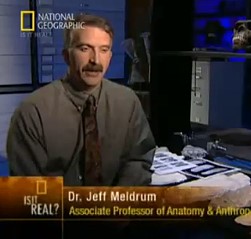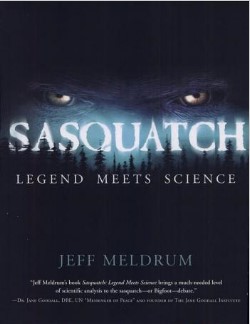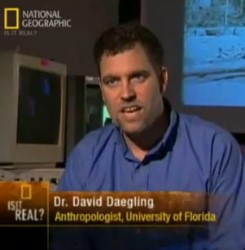
|
||||||||||||||||||
|
|
||||||||||||||||||
|
| ||||||||||||||||||
  


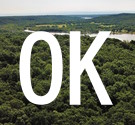





  









| ||||||||||||||||||
Problems with Wikipedia's 'Bigfoot' Article
posted by Matt Moneymaker; February 20, 2010Update: February 27, 2010
 |
 |
| Ingemar Ramell <ingemar333@yahoo.se> holds a copy of Berömda Vidunder in front of the main library for the University of Göteborgs in Sweden |
Some of our readers have said we should ignore the deceptive Wikipedia page for "Bigfoot" ... because even the founders of Wikipedia say that information on Wikipedia can be very unreliable.
The problem is ... people do use Wikipedia, and we'd be hypocrites if we said we didn't use it as well on occasion. So instead of ignoring Wikipedia as unreliable, we're seeking to make it more accurate about the bigfoot topic.
Unfortunately, no one can update those first few deceptive paragraphs of the Wikipedia article because some editor/administrator has control over it. That person repeatedly reverses any corrections and clearly favors the demonstrably misleading statements that you can see there today ... statements which could be fairly described as skeptical "woo-woo".
The first few paragraphs of the Wikipedia article are the ones most people will read and remember. The second paragraph contains some authoritative-sounding statements about the bigfoot subject, and the opinions of "the scientific community" about the topic. The article cites three sources in support of those statements.
One portion of one line states that the "scientific community" feels the survival of animals like sasquatches (bigfoots) in North America is "unlikely" due to unspecified "climate and food supply issues". One would expect some scientific substantiation for such a claim, but there is none. There is a footnote number for that statement. The footnote points to a book that is *not* a scientific journal, or any type of writing by a scientist ... but rather an obscure, out-of-print, untranslated book in Sweden titled "Berömda Vidunder". This obscure book may have been selected as the source for this skeptical woo-woo claim because it would be so difficult to confirm what that author actually said, or how he substantiated that assertion. One would have to go to Sweden to find a copy of that book and have it translated (it has never been translated to English ...).
But alas, the Internet has changed the game a bit. The BFRO has contacts around the world who can track down out-of-print foreign books cited for authoritative-sounding claims. Our man in Sweden, Ingemar Ramell, tracked down "Berömda Vidunder" in the library of the University of Götesborgs and discovered that ...
...wait for it ....
it makes no claims at all about the survivability of bigfoots (or "megafauna cryptids") in North America. It doesn't say anything that could even be confused in that regard ...
Ingemar writes from the University of Götesborgs, Sweden:
"I have now read the book 'Berömda Vidunder' - 206 pages. I have also read the last 3 chapters that covers the stories on bigfoot/Yeren/ Almas etc. I have read them 3 times and I can NOT find the text that Wikipedia is referring to.
I am used to reading strange books and to find "hidden" information in them, and to "read between the lines" I do that at the university all the time, but this information I just can not find. It is simply not there.
However, I did find on page 188 that the author is calling the Patterson/Gimlin film a bluff. In Swedish that means a fake. He is also writes on page 181 about the Albert Ostman story from the Toba Inlet, but he calls him "John Ostman".
I do not think that this man, even though well educated and a very nice writer (I did enjoy reading the book, will buy a copy when I find one) can judge whether or not sasquatches exist. He is referring to other writers the whole time such as Bernard Heuvelmans, John Napier, John Green, etc. for information on sasquatches. I do not think that he has ever been to the USA/Canada looking for them."
***
The Wikipedia citation to this obscure, out-of-print, untranslated Swedish book ... leads to two important questions regarding Wikipedia's "Bigfoot" article in general:
1) Who added those assertions to the Wikipedia article and cited that book without even reading it?
2) Who is presently insisting that this assertion and citation remain in the Wikipedia article?
Obviously there is some bad research going on somewhere, and perhaps even some corruption, especially if those particular assertions remain unchanged. Some anonymous person apparently has an agenda (perhaps commerical, perhaps religious) to falsely speak for "the scientific community" regarding this subject, and there's a Wikipedia editor protecting that position.
It would be a good time for uber administrators at Wikipedia to transfer control of that particular article to someone with superior credentials -- a true expert in the field of scientific skepticism who is familiar with the arguments on both sides. That person should decide the opening statements of the Wikipedia article.
The bigfoot/sasquatch phenomena is still a very open question, scientifically speaking. See Dr. Sherrilyn Roush's comments. She is a true expert on scientific skepticism.
Why the Wikipedia Article is so Important
Every year students here and there begin to ask questions about the bigfoot mystery for the first time. They ask their teachers. They ask their parents. Many end up writing school reports on the topic. Often they are directed to go online to look up information.
 |
Often the first thing students do is Google the keyword "Bigfoot". That search pulls up a list of web sites with bigfoot information. The list always includes a link to the Wikipedia's "Bigfoot" article, near the top.
Students, teacher and parents will often begin with the Wikipedia article, because they know Wikipedia usually provides reliable information.
The "Bigfoot" article in Wikipedia contains some amazingly biased information about the subject. The second line of the article reads:
"The scientific community considers Bigfoot to be a combination of folklore, misidentification, and hoaxes, rather than a real creature."
Informally, this is referred to as the "Daegling Doctrine." It was written by Dr. David J. Daegling, an associate professor
of anthropology at the University of Florida at Gainesville. He
wrote a book titled "Bigfoot Exposed". His doctrine-like assertion about a "consensus" among the scientific community is intended to make the reader believe the scientific community has evaluated the bigfoot phenomenon and agrees on a particular explanation.
Daegling has promoted his book on television programs and in newspaper articles over the past few years. The best promotion of all, however, comes from that first footnote in the Wikipedia article.
Let's analyze those opening assertions, and their supporting citations, beginning with the Daegling Doctrine:
"The scientific community considers Bigfoot to a combination of folklore, misidentification, and hoaxes, rather than a real creature."
First of all ... which definition of "Bigfoot" is at issue here? The
fictional character portrayed in advertisements and cartoons? Or the ape-like animals
that people see and call "bigfoot" ... ? They are two very different things, but they are often confused ... sometimes intentionally ...
Daegling typically characterizes the bigfoot question as whether there's "a giant hairy monster running around out there" ... clearly referring to the fictional character. When the controversy is phrased that way, it begs for a summarily dismissive response.
As to the real issue -- whether or not there is good evidence suggesting a possible undiscovered primate species in North America -- how would Daegling know what the "scientific community" feels about that? Did he take a poll of "the scientific community", or even some representative portion thereof?
No, he didn't.
The "scientific community" has never convened a committee to promulgate
a formal position on the phenomenon. Nor has anyone ever done any type of objective
survey among scientists ... so how does Daegling substantiate his claim? How
can Daegling speak for "the scientific community"?
He doesn't, and he can't.
First of all ... which definition of "Bigfoot" is at issue here?
Daegling characterizes the bigfoot question as whether there's "a giant hairy monster running around out there" ... clearly referring to the fictional figure, rather than the animals. (click video link ->) |
The Daegling Doctrine is what Daegling wants people to believe in order to protect his own reputation and career after writing his book claiming that bigfoots do not exist ... rather than any kind of surveyed consensus among scientists.
A scientist who promotes a science-oriented book firmly declaring that bigfoots
do not exist ... is forever compelled to provide a debunking explanation for
every sighting, and every piece of evidence, past, present and future.
His false assertion, mentioned so prominently in Wikipedia, helps deter academic, scientific and governmental interest in the topic and the sightings, etc.
Daegling is well aware that ongoing study and interest in the subject may produce even more compelling and corroborating evidence indicating the existence of these apes. That will inevitably lead to his humiliation as a scientist, not merely because he was wrong about their existence, but rather because of his book. Taken as a whole, it's 250+ pages of wrongness.
At some point along the path of writing his book it probably occurred to him
that he might be wrong, but by that point he was likely banking on his book
becoming a commercial success, to some degree. He had no choice but to skew
things however he needed to in order to support his underlying thesis. The book
is now a ticking time-bomb under his reputation and career. He can only hold
back that eventuality as best he can.
Consider these important factors related to the Daegling's assertion:
Americans do not have a monopoly on scientists. Nay, the number of scientists outside America outnumbers the scientists inside America. Most scientists outside America, if asked, would probably say they have never heard of "Bigfoot" before.
Most scientists within America are not anthropologists. Thus it is plausible that most American scientists would say they don't know enough about the subject to adhere to any particular explanation for it.
Of those American scientists who would have something to say about
... most would say they (personally) have not seen enough physical evidence
to substantiate the existence of these creatures. That's the only thing most
American scientists would be firm about ... unless they were being asked
about the fictional character "Bigfoot" ... which they can easily
be confused about, due to the terminology ... Daegling routinely bamboozles
people that way when he speaks or writes about the subject.
A more accurate line would be "Most scientists who have studied the subject would likely agree there is not yet enough physical evidence collected to scientifically verify the existence of a native ape species in North America."
That's a very, very different assertion than to say most scientists consider all the sightings and associated evidence to be the product of "folklore, misidentification, and hoaxes, rather than a real creature."
| Daegling's explanation for eyewitness observations: "Psychological problems." Click image above. |
Of course, some scientists would adhere to the Daegling's assertion ... but that does not mean most of them would. Scientists' attitudes change over time, depending upon the information they take in. Thus a doctrinal position like the one pushed by Daegling would not only require a wide-reaching, non-misleading survey among world scientists, but the survey would need to be renewed each year to adjust for shifting opinions.
If his definition of the scientific community is whittled down to those scientists
who would actually have firm opinions one way or another ... then we are starting
with a minority of scientists around the world, and perhaps a minority
of scientists in America. The Bigfoot topic is simply not one that most
scientists study or consider very much ... not enough for the "mainstream
scientific community" to adhere to a particular explanation for all the
evidence.
Scientists with an opinion would need to be surveyed to find out how
many of them fall into these different categories:
1) The scientists who would say there is a possibility for the existence of these creatures. Most scientists in this category would say they have not personally seen enough physical evidence to substantiate their existence, but they have an open mind.
2) The scientists who would say that all bigfoot sightings (and associated evidence) are generated by "a combination folklore, misinterpretations and hoaxes."
If such a survey was taken among scientists who have an opinion, the first category
may easily outnumber the second category . No one can say for sure either way
without an objective survey, including Daegling.
More lines in Wikipedia claiming to express the "mainstream scientific consensus".
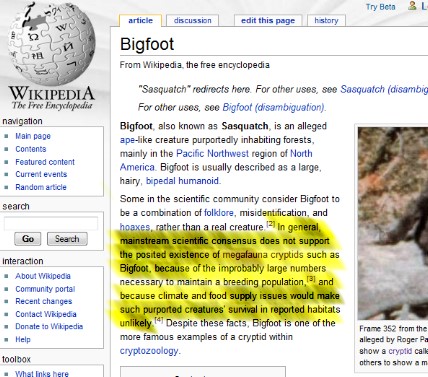 |
"In general, the mainstream scientific consensus does not support the posited existence of megafauna cryptids such as Bigfoot, because of the improbably large numbers necessary to maintain a breeding population[2], and because climate and food supply issues would make such purported creatures' survival in reported habitats unlikely[3]."
There's all sorts of problems here ... The most obvious problem: When and where did someone take a poll to get this "mainstream
scientific consensus" for such specific assertions? Was there an objective survey about this?
One can reasonably claim a "mainstream scientific consensus" about certain things without having to substantiate
the claim with a survey. For example, one could assert a mainstream scientific consensus for concepts like evolution and the spherical shape of the Earth, and the periodic table of elements, etc.
But when controversial subjects are involved, and especially when highly-respected scientists have divergent views on the matter, a Wikipedia editor cannot and should not endorse a very specific opinion on one side of the controversy by claiming there's a "mainstream scientific consensus" about it ... especially when it involves variables and definitions that are not fleshed out or substantiated elsewhere.
As for, the phrase " ... because of the improbably large numbers necessary to maintain a breeding population" ... That assertion is way, way too ambiguous and unspecific to be a "mainstream scientific consensus."
What are those "improbably large numbers"? The source does not mention any numbers, or any bio-geography formulas. So where did this assertion come from ... ?
The footnote in the Wikipedia article does not cite Daegling's book for this line (Daegling cited the same source in his book though ...). The Wikipedia article cites a newspaper article by a journalist named Stephanie Earl, who quoted a cultural anthropologist (i.e. not a physical anthropolgist) in Buffalo, New York, whose expertise is superstition and beliefs in the occult. Here's the actual paragraph from that article:
"It defies all logic that there is a population of these things sufficient to keep them going," says Phillips Stevens, a cultural anthropologist and ethnologist at the University at Buffalo. "What it takes to maintain any species, especially a long-lived species, is you gotta have a breeding population. That requires a substantial number, spread out over a fairly wide area where they can find sufficient food and shelter to keep hidden from all the investigators."
 |
But what about somewhere between 5,000 and 10,000 individuals, for all of North America? Is that not enough of a breeding population? Most zoologists would say it is quite sufficient, because there are many viable breeding populations around the world with much lower numbers. The numbers 5K-10K would actually make bigfoots the rarest large mammals in North America with a comparable geographic range.
In other words, a minimal viable population (MVP) for bigfoots does not have to be "improbably large" at all. One could not honestly claim it's a "consensus opinion" among scientists unless there were some clear, well established, bio-geographic formulae and calculations to support that notion. But there are none.
It would be difficult to apply a formula without homogenizing all the presumptions first (dietary, physiological, behavorial, environmental, etc.).
Also, where did Stevens get the idea that bigfoots have "kept hidden from all the investigators"? Does Stevens assume that no investigator has ever seen or heard one? Or does he assume that if an investigator "found" one he would surely kill it and bring it home, or at least obtain clear photos/videos of it.
Stevens apparently has no idea of the quality and quantity of Americans and Canadians who claim to have come across these animals. Nor does he have any idea of the typical circumstances for those observations (which make them quite challenging to document with a camera). Nor does he have any idea of the geographic pattern of reports which suggests they are indeed "spread out over a fairly wide area where they can find sufficient food".
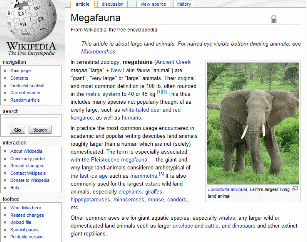 |
The most common defintion of "megafauna" is an animal bigger than a human. In other words ... white tailed deer, and elk, and moose and grizzly bears ... are all "megafauna". On the other hand, people commonly associate this term with Pleistocene megafauna -- the era of giant land mammals during (and following) the last ice age, such as the mammoth and giant sloth. The term can be ambiguous.
The term "cryptid" is less ambiguous. It simply means an undiscovered (but rumored) species.
Thus, technically, a "megafauna cryptid" is an animal species larger than a human, which has not been discovered yet.
A "megafauna cryptid" would not automatically need an especially large MVP (minimal viable population), nor would climate or food supply issues make a megafauna cryptid's survival unlikely in the reported habitats.
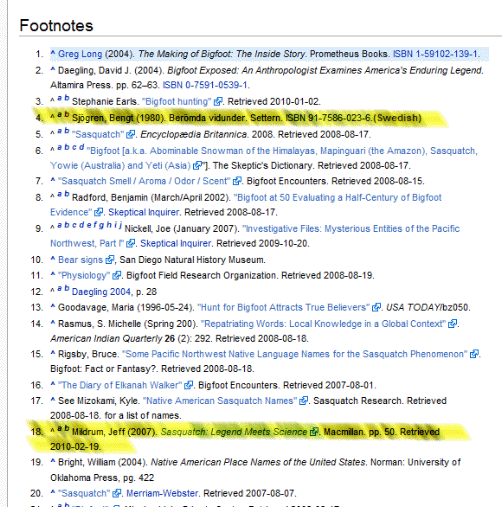 |
| The editor of the Wikipedia article cannot be criticized for mispelling Meldrum's name ... Afterall, he retrieved Meldrum's book for the first time only yesterday ... (Meldrum is the top scientific expert on this subject.) ... |
Bear, deer, moose, elk, etc., all survive quite nicely in their reported habitats. The climate is right for them. There's enough food for them, and they don't require "improbably large numbers".
Climate and Food Supply Issues
The article asserts that scientists believe there's not enough natural food in North America to support this species: ... "climate and food supply issues would make such purported creatures' survival in reported habitats unlikely."
For this assertion, the citation in the Wikipedia article points to the following
source:
Sjögren, Bengt (1980). Berömda vidunder. Settern. ISBN 91-7586-023-6. (Swedish).
But what exactly does that source say? How does this person support that assertion?
Well, that's almost impossible to determine ... because "Berömda Vidunder"
is an obscure, out-of-print book in Sweden which has never been translated into English,
either in whole or in part ... Thus there is no practical way to know what Bengt
Sjögren really said, or how he arrived at his ecological conclusions, or
what types of "megafauna" he was referring to ... unless one flies
to Sweden and searches for a copy of that obscure book, and then has it accurately translated to English.
Fortunately, our investigator in Sweden, Ingemar Ramell, has found a copy of that book and says it is not a scientific book but rather a popular book focusing mainly on aquatic cryptids, and to a lesser extent on terrestrial cryptids. It makes no assertions whatsoever about climate or food supply issues related to North American megafauna cryptids.
Yet that's the reference Wikipedia uses to substantiate the claim that scientists generally believe that "climate and food supply issues would make such purported creatures' survival in reported habitats unlikely."
North American forests still support large numbers
of large mammals, including hundreds of thousands of bears, most of which do
not hibernate in winter.
Any assumptions that a few thousand bigfoots could
not exploit the same resources would need to hinge on the assumption that bigfoots
have roughly the same diet as tropical apes.
They might not.
North America's natural food sources supported several million native
Americans for thousands of years. Although there would be less natural habitat
for hunter-gatherers nowadays, there still would be more than enough forest
land in North America to harbor between 5,000 and 10,000 semi-nomadic mammals
.... in the same types of habitats that hundreds of thousands of bears continue
to thrive in.
There would also be less competition for those resources formerly exploited
by native Americans, because no native Americans (or any other Americans) live
as true hunter-gatherers anymore, nor have they for over a hundred years. Thus,
there may actually be more natural food available to bigfoots now than ever
before. It's hard to prove that, but it's even harder to prove otherwise. Its
pretty illogical to suggest otherwise once you consider all the facts
and deconstruct the presumptions of such a statement.
Dr. Jeff Meldrum authored a book that claims bigfoots do exist.
Dr. David Daegling authored a book that claims bigfoots do not exist.
Daegling does not have a superior academic title above Meldrum. They are both associate professors of anthropology at their respective universities. In fact, Meldrum and Daegling attended Stony Brook University (NY) together, and both received their Ph.D.'s in Anthropology there, one year apart. Moreover, some anthropologists say Daegling seemed frustrated and envious of the positive attention his old schoolmate Meldrum had been receiving at anthropology conferences over the past 15 years, for his brilliant work on sasquatch track morphology.
If Meldrum were to write something to replace the Daegling Doctrine in the Wikipedia article, it might appear like this:
Of the scientists who have considered the bigfoot phenomena, most would say they have not seen enough physical evidence to substantiate the existence of these creatures, though an unverifiable number of scientists would also say they keep an open mind about the subject, and consider it an open question.
Wikipedia editors would not allow Meldrum's opinion to supplant Daegling's opinion,
because Meldrum is a bigfoot researcher who wrote a book advocating the existence
of these animals. That would make him a biased source, from their perspective.
But if Meldrum's opinion is biased because he wrote a book on the subject with
a particular slant, then Daegling's opinion is as biased too, because he wrote
a book on the subject with a particular slant also -- the opposite slant.
The fair and reasonable way to resolve the matter is to seek the opinion of
an objective expert -- someone who does not have a dog in this fight, but rather
someone who is an expert on science, evidence and skepticism.
An excellent candidate is Dr. Sherrilyn Roush at U.C. Berkeley. She has as Ph.D. in Philosophy from Harvard, and taught at Rice Univ., Harvard Univ., and now at Berkeley.
One of the class she teaches is "Philosophy of Science". The course description:
We study five topics of central importance where formal probabilistic approaches have brought progress. We ask: What makes something a scientific explanation?, What is required for observations to confirm (support) a hypothesis?, Is simplicity a guide to truth?, What is special about predicting novel data as opposed to accommodation of old data?, and Does the success of science give us reason to believe its theories are true? Topics covered include the problem of induction, some paradoxes of confirmation, and the advantages and disadvantages of Bayesianism.
Neutral Philosopher (Specialty: Skepticism in Science) |
|||
 |
Dr. Sherrilyn Roush |
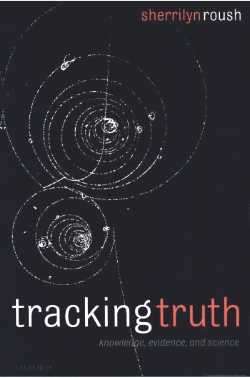 |
|
Dr. Roush stands outside the arena of the scientific community and analyzes it objectively, for a living. Her opinion about "the scientific consensus" (if any) surrounding the bigfoot controversy would be much more qualified, and far less biased, than Daegling's misleading assertions, which appear so prominently in that influential Wikipedia article.
 |
 |
Here's a preview of what Dr. Roush (a real expert on scientific skepticism) may say about the bigfoot subject (click icon). |
More about the Misleading parts of Daegling's Book ("Bigfoot Exposed")
| Review by American Daniel Perez (who was directly deceived by Daegling). Review by Canadian Tom Steenburg Review by Russian Dmitri Bayanov |
The biased administrator who controls the Bigfoot article on Wikipedia insists that Daegling's deceptive statements remain at the top of that article. Daegling's assertion tends to prejudice the opinion of people looking up info on the topic for the first time. One must ask if that controlling administrator has some agenda for doing this. The agenda is obviously not scientific objectivity. |

